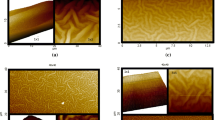Abstract
In this study, the sol–gel spin-coating method was used to produce pure CdO and 0.1% Li-doped CdO thin films. The main purpose of the study was to investigate the influence of the Li-doping ratio on the photoresponse of CdO thin film. Within this scope, pure CdO and Li-doped CdO chemical solutions were prepared and then deposited onto p-Si wafer and microscope glass as a thin film. Then, the surface morphology and photoresponse properties, etc. of the thin films were investigated. First, the morphological structure of the thin film was studied, and the roughness and size of the thin films were determined. Second, the photoresponse of the thin films was studied in order to determine the optical properties. In determining the photoresponse of the thin films, the films were studied and the transient photocurrent measured under both dark conditions and different luminous intensities. The ideality factor and barrier height parameters of the thin films were calculated as 3.5 and 0.81 eV, respectively. Finally, the capacitance–voltage (C–V), interface state density (Dit), conductance-voltage (G–V), and serial resistance (Rs) were studied at different frequencies. The obtained results showed that the Li-doping ratio changed the electrical and optical properties of the CdO thin film. This finding confirms that using different percentage Li-doping ratios, both the optical and electrical properties of CdO could be changed and improved for use in optoelectronic devices, either as a photodiode or as a photodetector.










Similar content being viewed by others
References
Z Ghorannevis, E Akbarnejad and M Ghoranneviss J Theor Appl Phys 10 225 (2016)
W Khan and A H Reşhak Indian J Phys 89 437 (2015).
A Abdolahzadeh Ziabari and F E Ghodsi J Alloys Compd 509 8748 (2011).
Y M Chen, T Ohkubo and K Hono Ultramicroscopy 111 562 (2011).
A Monemdjou, F E Ghodsi and J Mazloom Superlattices Microstruct 74 19 (2014).
Y Yang, S JinJulia, E Medvedeva, J R Ireland, A W Metz, J Ni, M C Hersam, A J Freeman and T J Marks Am Chem Soc 127 8796 (2005).
B Saha, R Thapa, S Jana and K K Chattopadhyay Indian J Phys 84 1341 (2010)
M Soylu, A A Al-Ghamdi, S B Omran and F Yakuphanoğlu J Alloys Comp 617 602 (2014)
T Ishizaki, T Ohtomo and A Fuwa J Phys D Appl Phys 37 255 (2004)
A E Rakhshani Thin Solid Films 536 88 (2013)
M Çavaş¸ F Yakuphanoğlu, Ş Karataş, Indian J Phys 91 413 (2017)
A A Dakhel Sol Energy 84 1433 (2010)
S Karatas and A Türüt Microelectron Reliab 50 351 (2010)
R K Gupta et al Physica E 56 288 (2014)
M Çavaş Iran J Sci Technol Trans A Sci 44 289 (2020)
R A L Wafi Silicon 9 657 (2017)
Ş Altındal and H Uslu J Appl Phys 109, 074 (2011)
Author information
Authors and Affiliations
Corresponding author
Additional information
Publisher's Note
Springer Nature remains neutral with regard to jurisdictional claims in published maps and institutional affiliations.
Rights and permissions
About this article
Cite this article
Çavaş, M. Fabrication and characterization of Al/LiCdO/p-Si optical sensor. Indian J Phys 96, 555–563 (2022). https://doi.org/10.1007/s12648-020-01986-y
Received:
Accepted:
Published:
Issue Date:
DOI: https://doi.org/10.1007/s12648-020-01986-y




